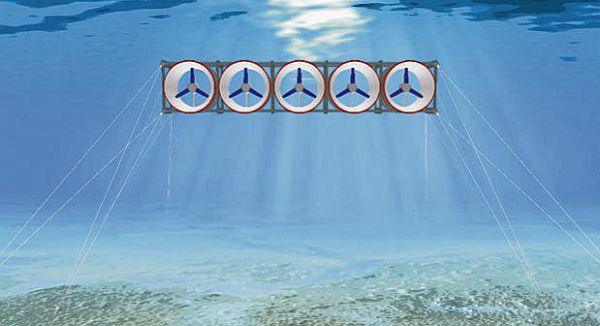 Attempting to make tidal energy available for commercial purposes, Sustainable Marine Technologies has devised a new 85 meter long Plat-O system having 5 one-megawatt horizontal-axis machines which can be connected to an existing mooring system. The design is planned in such a way that it would be relatively lighter than the conventional devices which weigh more than 1000 tonnes. Once the system is in place, it would be remarkably easy to position the turbines as they can be operated remotely to tap the energy of the “sweet spot” of the fast tidal stream current.
Attempting to make tidal energy available for commercial purposes, Sustainable Marine Technologies has devised a new 85 meter long Plat-O system having 5 one-megawatt horizontal-axis machines which can be connected to an existing mooring system. The design is planned in such a way that it would be relatively lighter than the conventional devices which weigh more than 1000 tonnes. Once the system is in place, it would be remarkably easy to position the turbines as they can be operated remotely to tap the energy of the “sweet spot” of the fast tidal stream current.
The Plat-O system, made up of composite and steel, weighing a lot lesser in comparison to its much heavier conventionally engineered counterparts, which weigh more than 1,000 tonnes, would open more avenues for tapping deeper water. Due to its light frame, lowering Plat-O to the seabed through the fast-flowing currents would be less risky. Installing the system is going to be cost-effective as a heavy-lift crane would not be required for hauling, positioning and placing the structure. Remote Vehicle Operators (ROVs) or underwater robots can easily be employed to install the mooring lines and the anchors of the system.
The turbine device can easily be hauled in a regular supply boat, thus making the entire installation process much simpler and less expensive. The design of the Plat-O system also makes it easier for it to install even in places such as Pentland Firth, where the water is 60-70 meters deep and the tides are considered to be one of the strongest. As the system can be towed, it removes the need for heavy lift vessels. This particular concept reduces the need for lifting from the surface making it possible to be installed by any number of low-cost vessels.
SMT has also taken care of the buoyancy aspect of the Plat-O system by integrating buoyancy modules via the built-in ducts into the frame so that the structure remains unaffected by the vertical wave loads. Furthermore, the buoyancy of the system is such that the entire frame can be floated back to the surface in order to repair a single turbine or the whole structure can be towed back to the harbor for further repair and maintenance. SMT is also developing a new ROV technology called the high flow which will provide controls for tightening or extending the mooring lines.
The real step towards the change is the flexibility and the usability that the system provides with its ability to export the power generated through 5 turbines to the shore, using a single subsea cable. The system also houses the power-conditioning equipment making it the ultimate choice for harnessing tidal energy for commercial purposes by different companies.
Via RechargeNews




